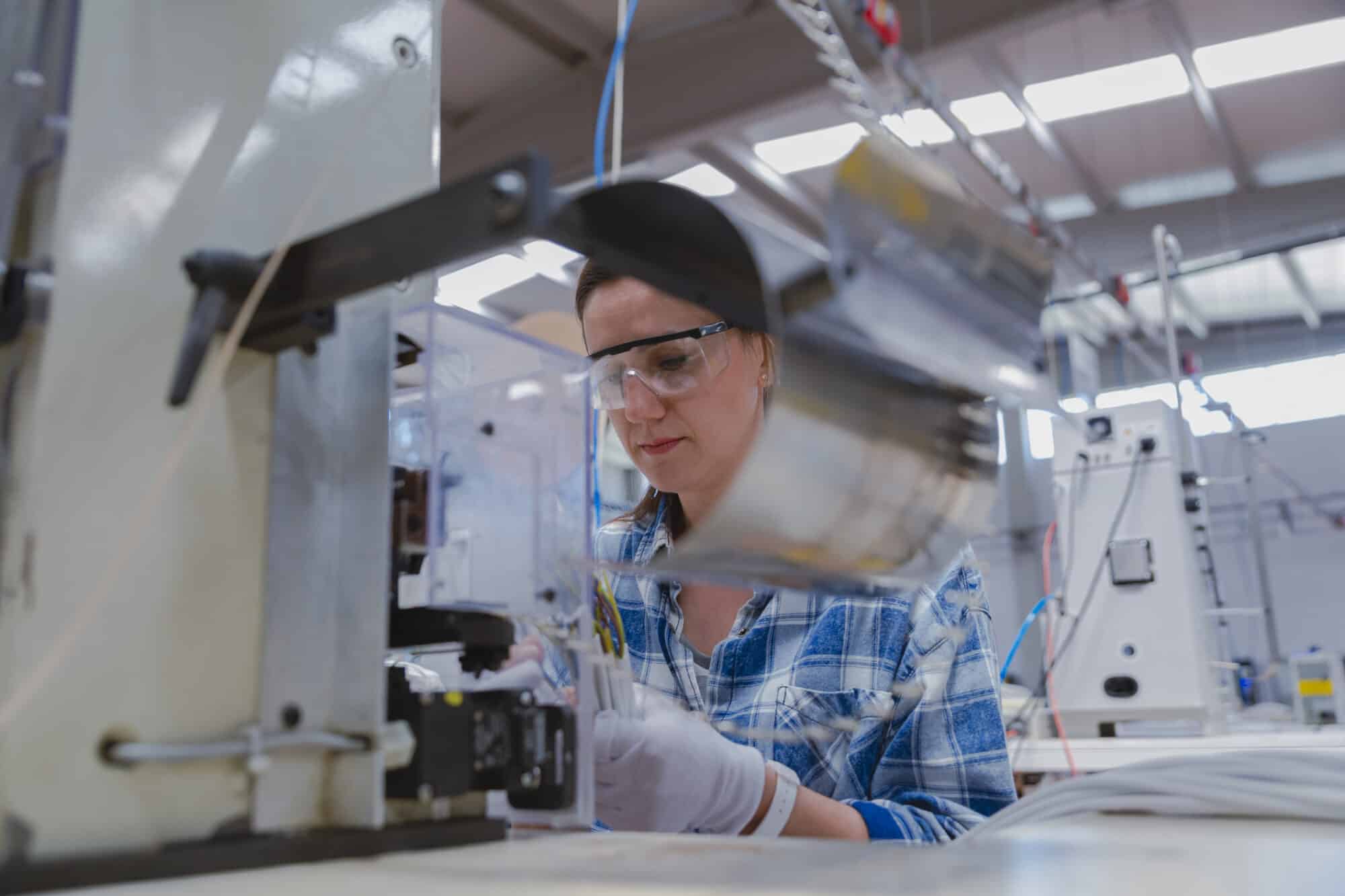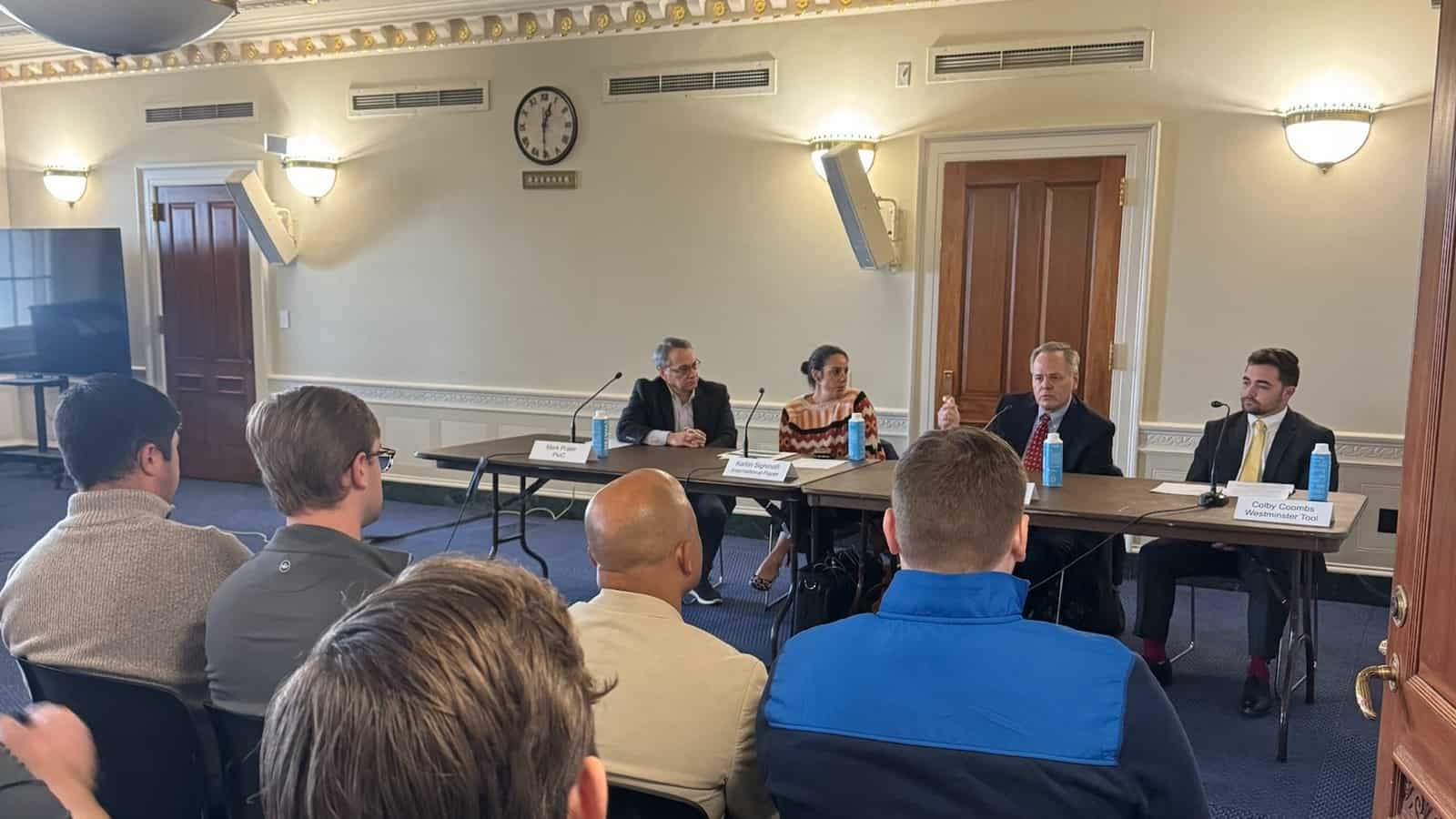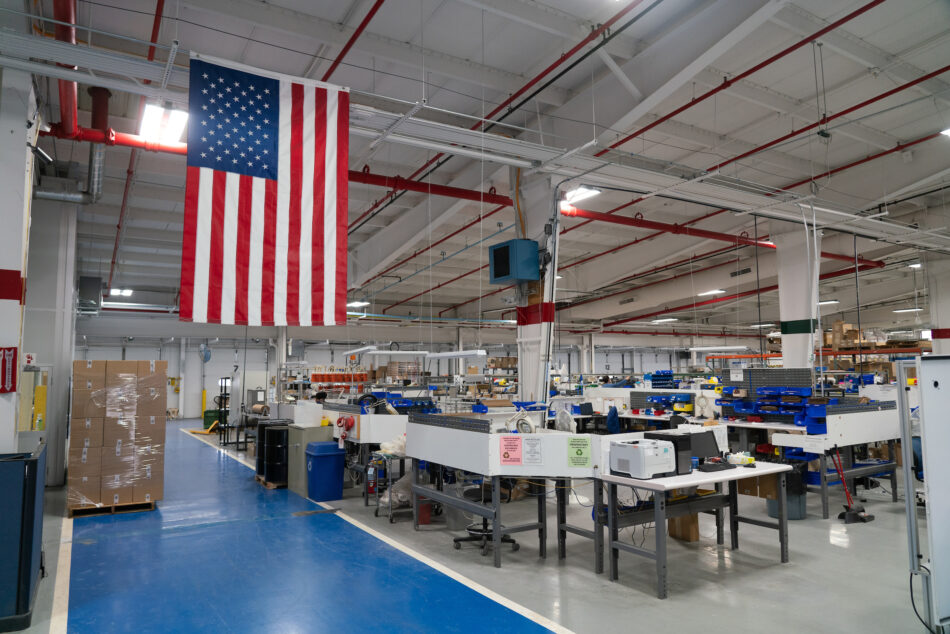Right-to-Repair Laws Harm Manufacturers and Consumers

So-called “right-to-repair” policies undo many of the federal and state laws designed to protect consumers and manufacturers—and they could result in “steep cost[s] to quality, performance, consumer safety, the environment and the broader U.S. economy,” according to a new NAM-commissioned study.
What’s going on: “The Economic Downsides of ‘Right-to-Repair,’” by Capital Policy Analytics’ Ike Brannon and Kerri Seyfert, finds that enacting right-to-repair laws could disrupt supply chains, leave manufacturers open to intellectual property theft, drive up costs for consumers and manufacturers and increase greenhouse emissions in the atmosphere.
- Right-to-repair policies, currently in place in more than 30 states, generally require manufacturers to make all tools, guides and parts required to repair their devices available to everyone, including independent repair outfits.
- A federal right-to-repair law “would ultimately alter how manufacturers operate their businesses, and there is no guarantee that consumers would benefit, as manufacturers would be forced to change the way their products perform,” according to the study.
Why it’s important: “There is a wide range of unintended and potentially harmful consequences that would arise if the most commonly introduced versions of ‘right-to-repair’ go into effect,” Brannon and Seyfert write.
- In addition to making product repair more difficult, such policies could drastically increase compliance costs for manufacturers and drive up prices for consumers.
Manufacturers to Congress: Restore Pro-Growth Tax Policies Now

In the third quarter of 2023, private-sector R&D spending fell by 1.2%, according to the Bureau of Economic Analysis. Since a harmful R&D amortization requirement took effect in 2022, R&D spending’s rate of growth has slowed dramatically, from 6.6% on average over the previous five years to less than 1% over the past 12 months.
- To protect well-paying R&D jobs and America’s competitiveness, Congress must restore immediate R&D expensing, manufacturers told Congress this week.
What’s going on: At a Monday briefing for staffers of the Main Street Caucus—a group of more than 70 Republican House members that advocates for small businesses—Westminster Tool Chief Financial Officer Colby Coombs talked about the harmful impact the R&D tax change has had on his injection-mold-making business.
- “We’re paying more than double what we made in cash profit last year to the IRS for federal income tax,” he said.
- “To put it differently, we paid just under an additional $27,000 per full-time employee in [our] tax bill this year. It is impossible to continue running your organization paying this amount in taxes [and] not being able to expense our research and development expenditures immediately.”
The background: For close to seven decades, the U.S. tax code allowed businesses to immediately deduct R&D expenses. But starting in 2022, it began requiring companies to amortize, or deduct, these costs over a period of years.
- Also in 2022, a stricter interest limitation—essentially a tax on investment—went into effect. According to a new analysis recently released by the NAM, the stricter limitation could cost nearly 900,000 jobs.
- Earlier this year, full expensing, which allows businesses to deduct the full cost of capital equipment purchases, began to phase down. It is set to fully phase out by 2027.
The effects: According to the Q2 2023 NAM Manufacturers’ Outlook Survey, 78% of manufacturers say the higher tax burden has decreased the funds available to expand core manufacturing activities in the U.S.
- The tax changes “forced us to cancel a major aviation contract this year that would’ve added five new jobs in our community,” Coombs continued. “Five jobs might not seem a lot, but that’s almost 17% of our workforce growth.”
- “We do what we love, which is make good products and make improvements for our country, [but] this is greatly handicapping our ability to continue to grow.”
NAM in action: The NAM has mounted an all-out campaign calling on lawmakers to reinstate immediate R&D expensing, pro-growth interest deductibility and full expensing (or 100% accelerated depreciation).
- Earlier this month, the NAM led more than 1,300 businesses and associations in calling for the measures’ reinstatement.
- It also launched the Restoring Pro-Growth Tax Policies Action Center, which provides background information on these priorities, as well as a digital engagement tool that helps manufacturers and industry advocates contact their senators and representatives.
The last word: Manufacturers are “absolutely vital … to continu[ing] to create good products that are safe and environmentally innovative to help our country,” Coombs said.
- “We need to be able to fully expense immediately, and we need to retroactively fix this [situation] so we can put our money into growing our workforce, purchasing new machines and improving our capabilities so we can compete at a global level.”
NAM, Partners: Pass MTB Now

For nearly three years, many manufacturers in the U.S. have been operating at a disadvantage to their foreign competitors due to the lack of a Miscellaneous Tariff Bill. And that needs to change, the NAM told Congress yesterday.
What’s going on: The NAM, along with more than 200 manufacturers and industry partners, urged key members of the House and Senate to pass the MTB as soon as possible this year.
- The measure—which expired at the end of 2020—temporarily eliminates or reduces tariffs on products not readily available in the U.S. and is typically renewed by Congress every few years on a bipartisan basis.
- The previous MTB was passed unanimously in 2018, and in June 2021, the Senate approved an amendment including it and other trade provisions by a strong bipartisan vote of 91–4.
Why it’s important: Since the last MTB’s expiration, manufacturers and other businesses have paid more than $1.4 billion in anticompetitive tariffs to get items they are unable to source in the U.S., according to an NAM analysis.
- In addition to incentivizing overseas manufacturing and costing jobs, the additional expenses are harming local economies and American taxpayers by increasing the prices on manufactured goods.
What should be done: “Congress can reverse course by passing the MTB through 2026 with meaningful retroactivity and reauthorizing future MTB cycles without broad and arbitrary restrictions that would be difficult to implement,” the NAM and partner groups said.
- “Congressional passage of the MTB will spur growth: according to the U.S. International Trade Commission, tariff relief under the previous MTB boosted U.S. GDP annually by as much as $3.3 billion and output annually by as much as $6.3 billion.”
The last word: “If Congress is serious about supporting manufacturers and workers in the United States, they must prioritize the passage of the MTB by the end of this year,” said NAM Director of Trade Facilitation Policy Ali Aafedt.
NAM Leads Business Community in Urging Restoration of Pro-Growth Tax Policies

To ensure that manufacturers in the U.S. can continue to create jobs and compete effectively in the global marketplace, Congress should extend three important tax policies, the NAM, along with more than 1,300 businesses and associations, told congressional leadership today.
What needs to be done: The House and Senate must act swiftly to ensure that the tax code supports innovation, enables businesses to finance growth and incentivizes capital equipment purchases.
- On R&D: Allow businesses to once again fully deduct research and development costs in the same year in which they are incurred.
- On interest deductibility: Reverse a stricter interest deductibility limitation that makes it more expensive to undertake job-creating investments.
- On full expensing: Extend 100% accelerated depreciation, which reduces the after-tax cost of capital equipment purchases.
The background: For nearly 70 years, the tax code allowed businesses to immediately deduct their R&D costs. However, beginning in 2022, the tax code began to require businesses to amortize the costs over a period of years.
- In the same year, a stricter interest limitation—which acts as a tax on investment—went into effect. This stricter limitation disproportionately harms manufacturers given their significant capital-intensive investments.
- Finally, full expensing, a critical pro-growth incentive, began to phase down this year and is scheduled to be eliminated completely by 2027.
NAM in the news: Bloomberg Tax and Semafor (both subscription) covered the NAM-led advocacy to Congress.
The last word: “On behalf of the millions of American workers whose jobs depend on a competitive U.S. economy, we urge all members of Congress to work together by year’s end to seamlessly reinstate immediate R&D expensing, restore a pro-growth interest deductibility standard and extend full expensing,” the NAM-led business community told Congress.
“Doing so will secure the U.S. as a global leader in innovation, incentivize job-creating investments and reinforce America’s competitiveness on the world stage.”
Study: Price Controls Could Harm Pharmaceutical Manufacturing

The pharmaceutical manufacturing industry is a critical piece of the U.S. economy, creating well-paying, valuable STEM jobs and contributing large sums in value-added output. However, federal price controls could threaten these benefits, according to a new study from the NAM.
What’s going on: The analysis, “Creating Cures, Saving Lives,” was released Wednesday and analyzes the industry’s contributions to the overall economy, as well as ways in which it could be affected by federal price control policies, such as those in last year’s Inflation Reduction Act.
- In August, the Department of Health and Human Services announced that it had chosen the first 10 drugs for prescription-cost negotiations required by the legislation.
- Last month, all 10 manufacturers “agreed to participate essentially because they had no choice,” according to reporting by The Hill.
Why it’s important: Controls on drug prices jeopardize innovation and competitiveness—which is why the NAM has long opposed them.
- What’s more, pharmaceutical manufacturing is a major contributor to the American economy, and government regulations should help, not hinder, it.
- “Pharmaceutical manufacturers are a major contributor to the U.S. economy, employ[ing] millions of Americans and driv[ing] innovation,” said NAM Chief Economist Chad Moutray. “The industry’s investments in R&D have led to lifesaving treatments and therapies that have improved the quality of life for all Americans. This study explores the negative implications of price control policies on pharmaceutical leadership, putting American jobs and innovation in the health care system at risk.”
NAM Leads Business Community in Urging Immediate Passage of Three Tax Policies Vital to American Manufacturing
More than 1,300 Industry Groups and Leaders call on Congress to restore pro-growth tax policies
Washington, D.C. – The National Association of Manufacturers, joined by more than 1,300 associations and businesses representing manufacturers of all sizes, today called on Congress to act quickly in advancing bicameral legislation that would ensure the tax code once again supports the ability of businesses to create jobs in the U.S. and compete in the global economy. In a letter sent to Congress, the coalition writes:
“We, the undersigned businesses and trade associations, collectively employ millions of Americans in all sectors of the U.S. economy. As tax policy plays a critical role in the ability of businesses to thrive, create jobs in the U.S. and effectively compete in today’s global economy, we write to urge Congress to take immediate action to seamlessly extend three tax policies vital to workers and America’s future: immediate R&D expensing, a pro-growth interest deductibility standard and full expensing.
“Although legislation has been introduced in both chambers in support of these policies, Congress must act immediately to extend these competitive tax policies. Failing to do so will put hundreds of thousands of family-supporting jobs, cutting-edge innovation and pro-growth investments in America at risk.”
The groups writes that Congress can secure the U.S. as a global leader in innovation, incentivize job-creating investments and reinforce America’s competitiveness on the world stage by:
Ensuring the tax code supports innovation: The private sector accounts for more than 75% of total research and development spending, with small businesses alone accounting for approximately $90 billion of all private-sector R&D investments. With wages and salaries comprising approximately 75% of R&D spending, the R&D amortization requirement is first and foremost a jobs issue, with R&D jobs paying an average wage of more than $155,000. Moreover, for every $1 billion in R&D spending, 17,000 jobs are supported.
Enabling businesses to finance growth: Prior to Jan. 1, 2022, businesses’ interest expense deductions were limited by section 163(j) to 30% of their earnings before interest, tax, depreciation and amortization. Interest deductions are now limited to 30% of earnings before interest and tax. By excluding depreciation and amortization, the stricter EBIT standard acts as a tax on investment, making it more expensive for capital-intensive companies throughout the supply chain to finance job-creating growth.
Making permanent a key incentive for capital equipment purchases: A 100% deduction for the purchase of equipment and machinery in the tax year purchased was in place from 2017 through 2022. Congress enacted full expensing to spur investments and ensure that the U.S. is well-positioned to attract capital in a competitive global marketplace. However, full expensing began to phase out at the beginning of 2023 and will be eliminated completely by 2027.
Click here to view the letter and the full list of signers.
-NAM-
The National Association of Manufacturers is the largest manufacturing association in the United States, representing small and large manufacturers in every industrial sector and in all 50 states. Manufacturing employs nearly 13 million men and women, contributes $2.91 trillion to the U.S. economy annually and accounts for 55% of private-sector research and development. The NAM is the powerful voice of the manufacturing community and the leading advocate for a policy agenda that helps manufacturers compete in the global economy and create jobs across the United States. For more information about the NAM or to follow us on Twitter and Facebook, please visit www.nam.org.
Manufacturers to White House: Revising Air Regulation Makes Nearly Half the Nation Ineligible for New Manufacturing Investment
Washington, D.C. – The National Association of Manufacturers, along with 71 leading business groups representing sectors across the economy, urged White House Chief of Staff Jeff Zients to help ensure that the Environmental Protection Agency maintains existing National Ambient Air Quality Standards for fine particulate matter (PM2.5).
“Manufacturers in America are committed to improving air quality and have been responsible for the development of new processes and technologies that have made our sector more sustainable,” said NAM President and CEO Jay Timmons. “The Biden administration’s proposal to make these standards even more stringent is putting manufacturing investment at risk across vast swaths of the country and will jeopardize nearly 1 million jobs. If the president and his agencies want the Bipartisan Infrastructure Law and the CHIPS and Science Act to succeed—and want to see manufacturing in America continue to grow—they should refrain from further changes to the standard, which is already among the most aggressive in the world.”
As the letter states:
A proposed discretionary revision to this standard, which is under review by the Office of Information and Regulatory Affairs, could put nearly 40% of the U.S. population in areas of nonattainment. Doing so would risk jobs and livelihoods by making it even more difficult to obtain permits for new factories, facilities and infrastructure to power economic growth. This proposal would also threaten successful implementation of the Infrastructure Investment and Jobs Act, the CHIPS and Science Act and the important clean energy provisions of the Inflation Reduction Act.
Our members have innovated and worked with regulators to lower PM2.5 concentrations significantly, and further progress is being made as part of the energy transition investments. The EPA recently reported that PM2.5 concentrations have declined by 42% since 2000, driven by major emissions reductions from both mobile sources and the power sector. As a result, America’s air is cleaner than ever.
A recent analysis conducted by Oxford Economics and commissioned by the National Association of Manufacturers found that the proposed standard would reduce GDP by nearly $200 billion and cost as many as 1 million jobs through 2031.
At 8 ug/m3, the lowest level considered by the EPA, more than 20% of all U.S. counties would be out of attainment and thrown into permitting gridlock.
To view the full letter, click here.
-NAM-
The National Association of Manufacturers is the largest manufacturing association in the United States, representing small and large manufacturers in every industrial sector and in all 50 states. Manufacturing employs 13 million men and women, contributes $2.91 trillion to the U.S. economy annually and accounts for 53% of private-sector research and development. The NAM is the powerful voice of the manufacturing community and the leading advocate for a policy agenda that helps manufacturers compete in the global economy and create jobs across the United States. For more information about the NAM or to follow us on Twitter and Facebook, please visit www.nam.org.
Manufacturers: AI Represents a Tremendous Opportunity for Modern Manufacturing
Washington, D.C. – Today, following the release of President Joe Biden’s Executive Order on Artificial Intelligence, National Association of Manufacturers Managing Vice President of Policy Chris Netram released this statement:
“Artificial intelligence represents a tremendous opportunity for modern manufacturing. AI is already helping manufacturers improve safety and training and empower workers to be even more innovative. It is unlocking incredible opportunities for predictive maintenance and product development, and manufacturers are continuing to develop further applications for AI. Manufacturers look forward to working with the administration following the executive order to ensure that any AI standards adopted at the federal level are developed with strong industry participation, support innovation and R&D, remain scaled based on the guardrails necessary for a particular technology or application, protect companies from unnecessary liability and bolster U.S. competitiveness and leadership in AI. Manufacturers also support strong data privacy and cybersecurity protections as well as robust investments in workforce development and prioritizing workforce needs through reforms to our immigration system.”
-NAM-
The National Association of Manufacturers is the largest manufacturing association in the United States, representing small and large manufacturers in every industrial sector and in all 50 states. Manufacturing employs nearly 13 million men and women, contributes $2.91 trillion to the U.S. economy annually and accounts for 55% of private-sector research and development. The NAM is the powerful voice of the manufacturing community and the leading advocate for a policy agenda that helps manufacturers compete in the global economy and create jobs across the United States. For more information about the NAM or to follow us on Twitter and Facebook, please visit www.nam.org.
Regulatory Onslaught Costing Small Manufacturers More Than $50,000 Per Employee
Washington, D.C. – The federal regulatory burden is now costing small manufacturers $50,000 per employee per year, according to the topline findings of a forthcoming National Association of Manufacturers study on the macroeconomic impact of the onslaught of federal regulations. The total cost of federal regulations, estimated at more than $3 trillion dollars, outpaced the economic output of the entire manufacturing sector.
“The unbalanced federal regulations make it challenging to grow manufacturing in America by siphoning resources away from job creation and our communities,” said NAM President and CEO Jay Timmons. “The burden continues to grow year after year, undermining the bipartisan achievements from President Biden and Congress that have prioritized manufacturing—including the Bipartisan Infrastructure Law and the CHIPS and Science Act. It is chilling investment, curtailing our ability to hire new workers and suppressing wage growth, especially for small and medium-sized manufacturers. It is time for the Biden administration to take action to reverse course.”
Additional Key Facts:
- The total cost of federal regulations in 2022 is an estimated $3.079 trillion (in 2023 dollars), an amount equal to 12% of U.S. GDP and larger than the manufacturing sector’s entire economic output ($2.91 trillion). The total annual cost of complying with federal regulations has risen by $465 billion since 2012, after adjusting for inflation.
- The annual cost burden for an average U.S. firm is $277,000, the equivalent of 19% of the average firm’s payroll expenses. A small manufacturer pays a burden of $50,100 per employee, meaning that a small firm with 20 employees bears around $1 million in annual compliance costs.
- For the manufacturing sector, the cost of federal regulations is roughly $350 billion, which equals to 12% of the sector’s value added to GDP. This is 26% higher than the inflation-adjusted cost of $277 billion borne by manufacturers in 2012.
- Surveyed manufacturers indicate that they could enhance their competitiveness if the costs of federal regulations were reduced; they would reallocate current compliance funds toward employee compensation and hiring, investment, research and development, sales and marketing, enhancing price competitiveness and improving return on investment.
- The regulatory burden on the manufacturing sector is larger than the economies of 29 American states.
To view the executive summary of the forthcoming study, click here.
Background:
The NAM and members of the Manufacturers for Sensible Regulations coalition have been leading voices on the negative impact of unbalanced regulations on manufacturers. According to the NAM’s Q2 2023 Manufacturers’ Outlook Survey, more than 63% of manufacturers report spending more than 2,000 hours per year complying with federal regulations, while more than 17% of manufacturers report spending more than 10,000 hours annually.
The NAM’s Q3 2023 Manufacturers’ Outlook Survey found that 69.1% of small manufacturers, and 63.2% of all respondents, would hire more workers or increase compensation if the regulatory burden decreased. Additionally, more than 70% of manufacturers would purchase more capital equipment if the regulatory burden on manufacturers decreased, with 48.6% increasing compensation, 48.6% hiring more workers, 42.5% expanding their U.S. facilities and 38.4% investing in research.
About the Study:
The NAM commissioned this analysis by economists Nicole V. Crain* and W. Mark Crain, who continued a three-decade effort to analyze the total cost of federal regulations, and how the burden is distributed across sectors and firm sizes. Two approaches are employed. The first is a survey of NAM members, conducted from July 20 to Sept. 1, 2023, to collect information about operational expenses dedicated to regulatory compliance, extrapolating these findings to the sector. The second approach derives estimates based on an aggregation of federal agency cost estimates, combined with regression analysis that measures the impact on overall economic output. The cost allocations by sector and firm size rely on data from the Bureau of Economic Analysis, the Bureau of Labor Statistics, the Census Bureau and the Internal Revenue Service.
*The views expressed in this study are those of the authors and do not reflect the official policy or position of the National Defense University, the Department of Defense or the U.S. government.
-NAM-
The National Association of Manufacturers is the largest manufacturing association in the United States, representing small and large manufacturers in every industrial sector and in all 50 states. Manufacturing employs nearly 13 million men and women, contributes $2.91 trillion to the U.S. economy annually and accounts for 55% of private-sector research and development. The NAM is the powerful voice of the manufacturing community and the leading advocate for a policy agenda that helps manufacturers compete in the global economy and create jobs across the United States. For more information about the NAM or to follow us on Twitter and Facebook, please visit www.nam.org.
NAM Sets the Policy Agenda for Manufacturing in the U.S.

The NAM is the voice of the manufacturing industry in the United States, speaking out on issues that matter to the men and women who make things in America. As times change, new issues arise, and to stay up to date with the needs of its members, the NAM updates its policy position documents accordingly.
That process—now underway for 2023—takes place with our member companies every four years under the guidance of the NAM Board of Directors. Here’s what you need to know.
The timeline: Proposed changes have been distributed from the NAM policy teams to the respective policy committees, and members have until Oct. 31 to provide their feedback.
- Shortly after Oct. 31, NAM policy committees will convene to consider the proposed changes and any subsequent suggested edits. If needed, working groups will be organized to consider new or revised language on specific issues.
The result: The NAM policy committees will recommend new policy language to the NAM Board based on their engagement with member companies.
- At the February 2024 board meeting, the NAM Board will finalize and approve the policy positions that will guide the NAM for the next four years.
How to participate: Member companies can choose which policy committees they serve on, so as the policy update process commences, companies should contact their membership directors to ensure they are aware of the various policies and committees that may be most important to their own businesses.
The last word: “Our member companies are at the center of this policy update process,” said NAM Managing Vice President of Policy Chris Netram. “The NAM fights every day for a policy agenda that supports manufacturing growth, and this is a critical opportunity for manufacturers across the country to have their say on the issues that matter to them.”
